#sex discrimination
Note
Random thought but have you ever noticed that breadtube is...misogynistic? Idk, as someone who used to watch a lot of breadtube (still a leftist, but as I've learned more about leftist politics and movements I find that breadtube often lacks substance - just seems like a lot of rambling without critical thinking/analysis).
Like, I can't help but notice that the lot of them shy away from topics around sex based oppression, male/female socialization, sexploitation etc (and if they're not ignoring it, they're saying that none of it is real and that those are just conservative talking points).
Idk. I just feel like a lot of people would rather watch transwomen talk about how important feminist works are actually bigoted to justify violent, misogynistic feelings toward radical feminists who discuss these things. It feels like they want to intellectualize misogyny and uphold a strawman of radical feminism so that they can validate telling women to shut the fuck up about our oppression. Am I making sense?
yes, you're totally making sense, and I decided to look into that. so I made an Excel list with the most prominent Bread Tubers, the number of their subscribers, their biological sexes and their gender identities:

if you just look at gender identity, the subscribers seem to be quite evenly distributed between men, women and non-binary people:
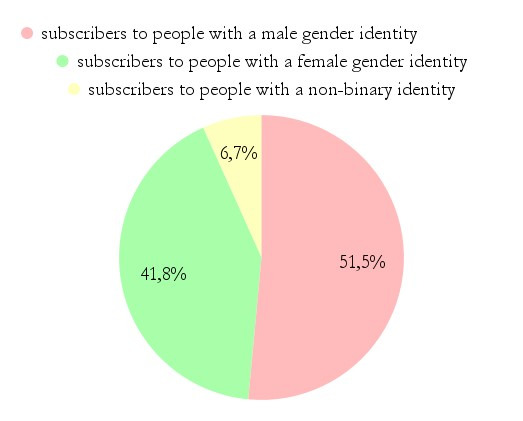
looks kinda fair, right?
but if we look into biological sex...
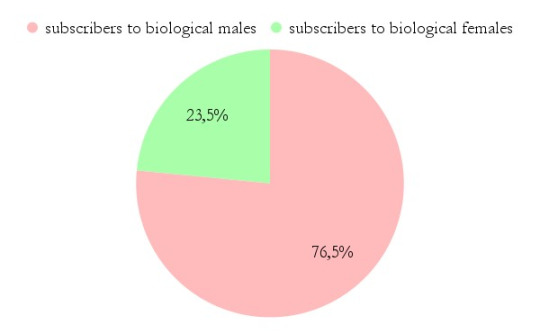
it's suddenly clear that biological males gather about 77 percent of the total subscribers, while biological females gather only about 24 percent.
doesn't seem that fair anymore, right?
but it gets even worse when you take into account the male's gender identities...

there are more subscribers to biological males with female or non-binary gender identities than subscribers to biological females???
I guess there is your answer on why bread tube does not cover issues of sexism and sex-based oppression.
...and that is why an analysis based on biological sex is important and trying to erase it will let us believe that we are closer to equality between the sexes than we actually are
#I still watch some of them and think many have good analyses#for example on topics of history#but I will never#ever#try to know anything about sexism and misogyny by them ever again#breadtube#bread tube#leftist youtube#sex discrimination#trans#transgender#trans woman#listen to trans women#terfblr#terfs please interact#radical feminism#it took a while to make these graphs so#radblr#radfems please interact#gender critical#radical feminists please touch#radical feminists do interact#feminism#listen to women#misogyny#terfs please touch#gender critical feminism#gender critical feminist#gc feminist#gc feminism
438 notes
·
View notes
Text
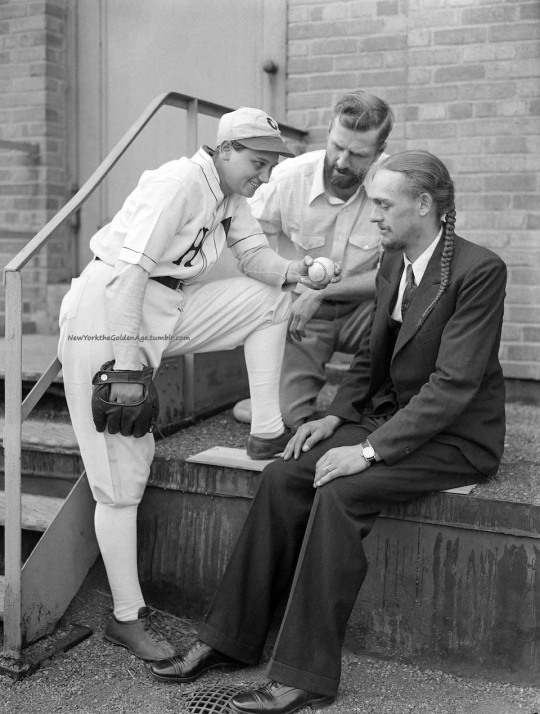
19-year-old southpaw Jackie Mitchell, of the House of David baseball team, speaks to her teammates while in New York, July 14, 1933. Mitchell was the first and only woman to have a contract in Major League baseball, with the Chattanooga Lookouts. Two years earlier, in an exhibition game during spring training, she had struck out both Lou Gehrig and Babe Ruth―in six pitches.
There is some controversy about that―not that it didn’t happen, because there is a film of it―but as to whether the Yankee aces were doing it just for show. Mitchell always maintained that it was genuine. “Why, hell, they were trying, damn right,” she said. “Hell, better hitters than them couldn’t hit me. Why should they’ve been any different?”
Timothy Wiles, who served as the Baseball Hall of Fame Research Director for about 20 years, said, “If she did this today, it would become a permanent part of the consciousness because of the media we have. If ESPN was around, it certainly would be their lead story.”
Mitchell was quoted at the time saying she learned to throw from her neighbor, MLB's Charles Arthur “Dazzy” Vance, who was later inducted into the Hall of Fame. Her contract was cancelled by baseball commissioner Kenesaw Mountain Landis after he heard about her spring training feat in 1931.
Photo: Associated Press via the Washington Post
#vintage New York#1930s#vintage baseball#baseball#pitchers#women in sports#women in baseball#Jackie Mitchell#July 14#14 July#sex discrimination#women's rights
222 notes
·
View notes
Text
#radfem#women#patriarchy#gender inequality#sex discrimination#gender hierarchy#misogyny#radical feminism#feminism#news#UN report#the guardian#bias against women#discrimination
64 notes
·
View notes
Text
By: Aida Cerundolo
Published: Nov 16, 2023
What do forced sterilizations, the Tuskegee experiment, and the Holocaust have in common? They all demonstrate doctors forgetting their commitment to heal humans.
When doctors redirect their priorities to political matters outside the exam room, patient care suffers. That’s why doctors pledging to further social justice initiatives while treating individual humans may be blinded to the risk of harm.
We’ve seen this time and again throughout history. Social Darwinism in the early 20th century, for example, inspired doctors to pursue a genetically fit society through forced sterilizations of the “feeble-minded.” Doctors conducting the Tuskegee experiment to better understand syphilis caused suffering and death by withholding treatment from impoverished black patients. And German doctors motivated by the Nazis’ twisted idea of a better society marked prisoners for death in the mass extermination of Jews.
Why would people trained to heal inflict such pain on their fellow man?
Emboldened by a faith in the latest science and an assumption that certain humans hold less value than others, these doctors overlooked the harm to individuals while zeroing in on a perceived greater good to society. A shift in focus away from the sanctity of every individual is the Achilles' heel of medicine that makes doctors vulnerable to repeating the same mistakes. As Dr. Ashley K. Fernandes explains in " Why Did So Many Doctors Become Nazis? ," “Society is created for the person, not the person for society, and hence the dignity and integrity of the person and her freedom cannot be sacrificed for the sake of society.” Prioritizing the individual is the guardrail that steers medicine away from future carnage.
But it is exactly this shift in focus from the individual to society that social justice advocates demand in the medical field. The American Medical Association carries the social justice torch in its " Organizational Strategic Plan to Embed Racial Justice and Advance Health Equity ," declaring, “Inequities cannot be understood or adequately addressed if we focus only on individuals, their behavior or their biology.” Doctors are told to “confront inequities and dismantle white supremacy, racism, and other forms of exclusion and structured oppression, as well as embed racial justice and advance equity within and across all aspects of health systems.”
Reducing barriers to treatment is necessary to improve healthcare delivery and minimize disparities. But linking immutable characteristics such as skin color with power and privilege in the medical setting rationalizes the distribution of care based on arbitrary factors in the name of a greater good called social justice. This hazards some patients with negatively designated characteristics as being viewed as less valuable than others, potentially impeding the care they need.
The New York State Department of Health prioritized immutable characteristics when recommending that monoclonal antibodies and antivirals to treat COVID-19 be fast-tracked for those of “non-white race or Hispanic/Latino ethnicity” because “longstanding systemic health and social inequities have contributed to an increased risk of severe illness and death from COVID-19.” This approach bypassed patients at risk for severe disease simply because they were born the wrong color.
Despite the illogic of immutable characteristics dictating healthcare, some state medical boards have taken heed of the AMA’s call for mandatory anti-racism lessons and require implicit bias training for doctors to obtain or renew their medical license. Similar courses in medical schools ensure dissemination of the idea that patients be viewed through a racial lens.
The AMA’s strategic plan goes so far as to dissect the white population into even more specific subgroups of oppressors, calling out those who are “wealthy, hetero-, able-bodied, male, Christian, U.S.-born” as keepers of a system that permits their own success at the expense of non-whites and non-Christians. Social power dynamics are described in painstaking detail, while the most important power differential in the exam room — that between the doctor and the patient — is ignored.
Patients must trust that doctors are objective and sincere in their mission to heal, no matter the characteristics of the humans in front of them. Categorizing people as oppressors or oppressed, privileged or deprived, based on skin color, ethnicity, religion, or otherwise, is the start of normalizing their dehumanization, a dangerous practice that has historically resulted in unspeakable horrors. A rejection of labels and a focus on the sanctity of every individual is the only insurance against future barbarity in the name of societal gains.
==
This is what systemic racism and systemic sexism look like. Activists call it "equity," and it comes with a death toll.
Needs lawsuits.
#Aida Cerundolo#medical corruption#medical equity#equity#discrimination#racial discrimination#sex discrimination#institutional capture#ideological capture#needs lawsuits#oppressor#oppressed#woke#wokeness#wokeness as religion#wokeism#cult of woke#religion is a mental illness
9 notes
·
View notes
Link
18 notes
·
View notes
Text

5 notes
·
View notes
Text
Happy to see on recent flights the female flight attendants in normal, flat, comfortable looking shoes. Nature is healing! No more uncomfortable women in stilettos walking up and down the aisles, with their male colleagues in normal, flat, comfortable looking shoes.
2 notes
·
View notes
Text
No Googling! I'll post the answer when the poll closes.
#EEOC#Employment Law#Equal Employment Opportunity Commission#Workplace Discrimination#Age Discrimination#Disability Discrimination#Racial Discrimination#Religious Discrimination#Workplace Retaliation#Sex Discrimination
5 notes
·
View notes
Quote
Until 1975, when sex discrimination legislation made the restriction unlawful, no woman was allowed to remain in A4 [surveillance] for more than five years because, as Director B wrote in 1967, 'Once we allow a woman to stay for over five years we should find it very difficult in practice to get rid of her at all.'
Christopher Andrew, The Defence of the Realm
#quote#quotation#Christopher Andrew#The Defence of the Realm#sex discrimination#restriction#surveillance#women#and obviously you quit when you get married#what else would you do
2 notes
·
View notes
Text
“ He said the federation had based its decisions on one main criterion: the ability to compete for medals -- and the men had better chances.” Ladies let’s send our prayers, spells, etc to the Women cyclists to give them a boost after this and make this jackass eat his words.
The French Cycling Federation on Saturday defended its decision to pay for business seats for male cyclists while its women's team flew economy on the long trip to the World Championships in Australia.
While the men's team, including two-time defending world champion Julian Alaphilippe, travelled in comfort, the seven women riders as well as the rest of the delegation including male and female competitors entered in the junior events and the support staff, were all in the back of the plane.
The first report in a French newspaper provoked a storm of protest on social media.
Christophe Manin, French cycling's national technical director, told AFP that flying the team to Australia "costs a lot of money."
"Some countries, like Ireland, have decided not to participate in the World Championships. We asked ourselves if we should take all the categories, especially the juniors. We did it.
"But we don't have the means to put everyone in business," said Manin, who decided not to make the trip himself to save money.
He said the federation had based its decisions on one main criterion: the ability to compete for medals -- and the men had better chances.
"For the men, we've been world champions for the last two years. We are really going there to win, while we are more of an outsider in the girls' competition", he said.
"If we had the mountain bike world championships in Australia with the same economic choice to make, we would put the two girls in business and the boys in economy", he said, because French women riders Pauline Ferrand-Prevot and Loana Lecomte have better results than the men.
Team manager Thomas Voeckler travelled economy for the championships in Wollongong outside Sydney.
2 notes
·
View notes
Text
"we are not bioessentialist! we don't think that women = hair and nails, and men = logic and sports"

also, the only person pointing out the blatant sexism gets downvoted and their post is deleted now lmaoooooo

credits go out to sweetstarcollector ✨
#radfem#gender critical#trans#transgender#radical feminism#terfblr#terfs please touch#radfems please touch#gc feminism#gc feminist#gender stereoptypes#radblr#radical feminists do interact#radical feminists please touch#feminism#sexism#sex discrimination#womens liberation
82 notes
·
View notes
Text

Jobs were hard to come by even before the Depression. Out of the 6,000 men and women who stormed the Free Employment Agency at 60 Lafayette St. on August 18, 1920, only 135 found jobs.
This was the "Females" section. Job postings were sex-segregated in those days, with women being offered positions in domestic service and low-level clerical work. This practice continued for more than 50 years.
Photo: Bettmann Archive/Getty Images/Fine Art America
#vintage New York#1920s#unemployment#job hunting#August 18#18 August#18 Aug.#Aug. 18#Roaring Twenties#Jazz Age#old NYC#sex discrimination
42 notes
·
View notes
Text
#radfem#women#patriarchy#sex discrimination#gender inequality#gender discrimination#gender hierarchy#news#research#feminism#radical feminism#misogyny#bias against women#discrimination
18 notes
·
View notes
Text
By: Lawrence M. Krauss
Published: Sep 11, 2023
The voyage of discovery that science offers can take us furthest when it is open to the best and brightest, regardless of who they are and where they come from. Great scientific minds often emerge from unexpected backgrounds. Many scientific disciplines remained effectively closed to ethnic minorities and to women for far too long. But over the past 50 years at least, science has opened up and a host of affirmative action programs have been created to encourage women and minorities to consider careers in the field.
For some activists, however, these efforts have not gone far enough. In response, universities, industries, and research institutions have instituted a vast bureaucracy designed to promote Diversity, Equity, and Inclusion: a behemoth that is growing at a rate far exceeding that of investment in new faculty and facilities.
This has resulted in some disturbing new trends in academia and scientific institutions more broadly. In a desire to include women and minorities, white males are often excluded, and too often women and members of minority groups are tokenized by being promoted primarily for their gender or skin color.
This tokenism has affected the most prestigious institutions. It was a bone of a contention at this year’s Lindau Nobel Laureate meeting. Citing fellow laureate Christiane Nüsslein-Volhard, who has questioned the use of gender quotas in STEM and warned against “discrimination against men,” Nobel prizewinner Kurt Wüthrich commented that he felt discriminated against “in the climate that this meeting is being held.” He was particularly dismayed by the fact that the female laureates were placed in the front row of a group photo—an example, he felt, of insulting tokenism. “I would feel horrible if presented in this way,” he said. “It was ridiculous, fully ridiculous.” As a result of voicing these views, Wüthrich was accused of violating the meeting’s code of conduct.
That may have been a minor issue of optics, but his more general point is valid. Look at almost any online photo promoting science and you will find this kind of tokenism.
Here are several examples.
The first is from a recent article in Science, the official journal of the American Association for the Advancement of Science.

[ Source: Science. ]
Scientific societies should encourage all young people to consider a career in scientific discovery. Science nevertheless seems to feel the need to present a patronizing advertising image, featuring three women and two men of color.
In an email encouraging young people to embark on scientific careers, the American Physical Society presents an image of five women and a black man. The omissions—presumably done in the name of diversity—are obvious and embarrassing.

[ Source: Substack. ]
In advertisements for their annual general meeting, which attracts over 10,000 scientists from all over the world, the APS shows three women and one male of color.

[ Source: APS website ]
For hundreds of years, white men in lab coats were presented as the face of science. It is time to change that picture. But we should do without losing touch with reality or becoming overtly patronizing.
This trend of prioritizing women and minorities is not restricted to advertising and public relations but is affecting faculty appointments at every level.
Let’s start at the top. Six of the eight Ivy League universities—Harvard, Brown, Penn, Cornell, Dartmouth, and Columbia—now have female presidents, as do UC Berkeley and MIT.
MIT is a particularly striking case. Despite comprising many traditionally male-dominated STEM disciplines, its upper management team is largely female. The head of the MIT Corporation, the President, the Director of Research, the Provost, the Chancellor, and the Dean of Science are all women. The Institute’s core discipline, the School of Engineering, consists of eight departments, five of which are led by women. This is clearly not a coincidence, nor is it likely, given the demographics of the place, that this is simply the result of choosing the best people for those jobs. Were the situation reversed—if most of the faculty were female, but the leading administrators were all male—there would be an outcry.
It is still the case that most full professors, in most STEM disciplines, are male. But the reasons for this are often misunderstood. It generally takes decades to attain this rank, and many full professors have been in their current positions for over 30 years. Even if the hiring system were now biased in favor of women, they would not yet have achieved parity at the senior level.
And the hiring system may well be biased. Thanks to the Diversity, Equity, and Inclusion infrastructure that dominates almost every major US university today, affirmative action initiatives have affected the hiring of junior faculty across the board.
It is difficult to obtain national statistics on this, but in 2015, before DEI initiatives reached current heights, a study published in the Proceedings of the National Academy of Sciences revealed a two to one preference for female candidates for tenure track positions in STEM.
New faculty announcements suggest a similar bias. For example, in 2021, UCLA announced the following new appointments in the physical sciences: Abigail Doyle (Chemistry and Biochemistry), Alvine Kamaha (Physics and Astronomy), Courtney Shelly (Statistics/Mathematics), Qianhui Shi (Physics and Astronomy), and Hong Wang (Mathematics). It did not appoint any new male faculty. Similar examples abound.
We can detect comparable trends further up the tenure ladder, too. For example, MIT has just announced the election of six new Fellows to the American Physical Society. This represents a significant career milestone for the successful candidates. I was happy to see that they include my well-deserving former graduate student, Hong Liu, but that aside, the trend seems clear.

[ Source: MIT News ]
Affirmative action is not the only explanation for the increasing paucity of white males in such positions. The American Physical Society offers a plethora of programs designed to assist pre-tenure female (and sometimes male minority) faculty in physics. There are conferences, leadership programs, internships, grants, workshops, networks, site visits, guidelines, scholarships, fellowships, and prizes. There are no similar programs for young white male scientists, although many of them face similar career challenges.
In US academia in general, women now receive more doctoral degrees than men.
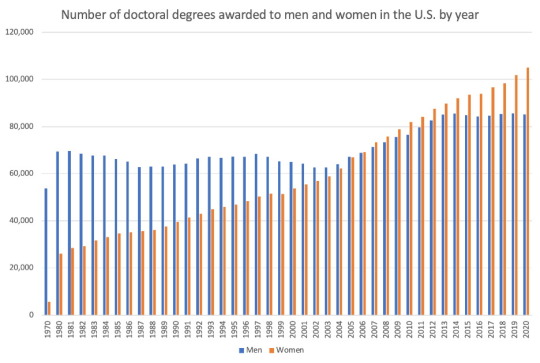
[ Source: Cory Clark and Bo Winegard for Quillette ]
Women also occupy most faculty positions in post-secondary institutions.
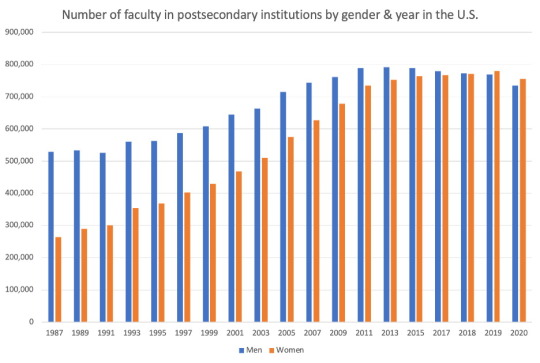
[ Source: Cory Clark and Bo Winegard for Quillette ]
While it is heartening that the climate for women in academia has been improving, these figures suggest that the laser focus on recruiting, retaining, spotlighting, and promoting women in STEM may have become superfluous.
As April Bleske-Rechek and Michael Bernstein have shown, while men still occupy three quarters of STEM positions (despite the fact that the percentage of women in STEM has more than doubled since 1980), the situation is precisely reversed in the fields of health, education, administration, and literacy. While massive efforts are underway to correct the imbalance between men and women in STEM, there have been no concomitant efforts to increase the numbers of men in female-dominated professions. People do not seem to perceive the latter imbalance as a problem. In a recent survey of over 800 recent college students, Bleske-Rechek and Bernstein found that the students were overwhelmingly more concerned about male overrepresentation in certain high status professional positions than about female overrepresentation in others.
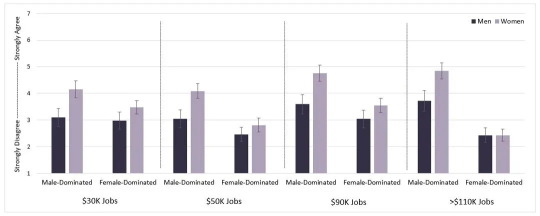
[ Responses to the question "Do you agree that the gender gap is problematic?" Source: Unsafe Science. ]
This was the case even though the female-dominated disciplines were not considered lower status than the male-dominated ones.

[ Responses to the question "Do you agree that the job is high in status?" Source: Unsafe Science. ]
Other data in the study suggest that gender gaps in male-dominated disciplines are significantly more likely to be attributed to sexism or discrimination than they are in female-dominated disciplines.

[ Responses to the question “How much of the gender gap is due to sexism/discrimination?” Source: Unsafe Science ]
These results align with recent work by Matt Grawitch et al., summarized here. Grawitch and his colleagues found that both male and female respondents were more likely to judge that an interaction between a banker and a client had been sexist when the banker was male and the client female than the reverse. We are far more likely to attribute sexism to disparities that favor men than disparities that favor women.
The impression that universities are primarily concerned with hiring, supporting, and promoting women may be contributing to the fact that, at entry levels, young men are leaving higher education in their droves.
We can see the results of this in the California State universities: the undergraduate student body at Cal State Los Angeles is 59 percent female, and 67 percent of its graduate students are female; Sonoma State is 63 percent female; San Diego State is 57 percent female; Humboldt State is 58 percent female; Cal State East Bay is 61 percent female. Nationwide, around 60 percent of students are female. And the gender gap is growing. Recent data show a significant downward trend in male college enrollments, which has coincided with the increasing prevalence of DEI programs.

[ Source: Brookings Institution ]
The reduction in male undergraduate numbers is partly caused by the fact that young women are graduating from high school in higher numbers than their male counterparts. In fact, women now graduate at higher rates than men at all educational levels.

[ Source: Brookings Institution ]
Similar trends are emerging at pre-university level. Consider this announcement of the finalists and winners of the 3M Young Scientist Challenge.

[ Source: 3M News Center ]
It is no surprise to see a high prevalence of Indian and Chinese students among this group, as East and South Asians have been outperforming white students for some time. What is perhaps more surprising is that the finalists included only one young Caucasian male.
Perhaps this is partly due to way such programs recruit applicants. Consider this advertisement for the Regeneron Science Talent Search.

[ Source: Society for Science ]
Is the nearly complete absence of white males in these images the result of a decision to highlight women and minorities—or are fewer white men getting involved in such programs than ever before?
We may be moving towards a future in which women will be significantly better educated than men and will occupy far more of the jobs that require professional qualifications and skills. The societal impacts of this are unknown.
We must continue to ensure that higher education and scientific training remain open to people from all demographics. But we should not encourage diversity at the cost of driving away talented people. Our fixation on raising the profile of women and minorities in science by minimizing the role and status of men in general, and white men in particular, is misplaced.
After more than 40 years of intense affirmative action efforts, it may be time to take our thumbs off the scale and let a natural balance emerge. Young males—and white males in particular—should not be discouraged from pursuing higher education in science, or from engaging in any other field of intellectual activity.
[ Via: https://archive.md/18k9n ]
==
DEI does not belong in science.
#Lawrence M. Krauss#science#diversity equity and inclusion#diversity#equity#inclusion#affirmative action#diversity hire#sexism#anti male#anti male bias#sex discrimination#sexism against men
7 notes
·
View notes
Text
(news.artnet.com/art-world/gender-discrimination-art-study-2171375)
In a Series of Behavioral Experiments, Viewers Preferred Works by Women Artists—But Assumed Works by Men Were More Famous and Valuable
Sarah Cascone, September 7, 2022

Mary Cassatt, Ellen Mary Cassatt with a large bow in her hair (1909). Private collection. John Singer Sargent, Portrait of Jeanne Kieffer (1879). Private collection.
Does gender bias affect our opinions about work made by male and female artists? According to a new study, people aren’t more likely to prefer a work by a man than a near-identical composition by a woman—but they’ll assume that his work is more famous and worth more money.
“Gender discrimination in art comes not from personal aesthetic preference—[Georg] Baselitz’[s] argument that women ‘don’t paint very well’—but people thinking paintings are more valuable and famous when painted by male artists,” study authors Robert Hoffmann, a professor of behavioral economics at the University of Tasmania, and Bronwyn Coate, a senior lecturer in economics at the Royal Melbourne Institute of Technology, wrote in the academic journal The Conversation. (https://theconversation.com/male-artists-dominate-galleries-our-research-explored-if-its-because-women-dont-paint-very-well-or-just-discrimination-189221)
These findings are perhaps unsurprising, considering that men dominate the art market. As of 2019, women represented just 2 percent of art sales at auction. At 26 prominent American museums, they made up a mere 11 percent of acquisitions and 14 percent of exhibitions.
(https://news.artnet.com/womens-place-in-the-art-world/female-artists-represent-just-2-percent-market-heres-can-change-1654954) (https://news.artnet.com/womens-place-in-the-art-world/womens-place-art-world-museums-1654714)
Such statistics, therefore, skew our perceptions of otherwise remarkably similar works of art, causing viewers to assume that male artists are more successful and command higher prices. In other words, we assume that other people discriminate based on gender, which in turn creates more opportunity for gender discrimination in a vicious cycle.

Ambrosius Bosschaert, Flowers in a Glass Vase. Collection of the National Gallery, London. Maria van Oosterwijck, Flowers in a vase on a marble ledge (after 1680). Private collection.
Titled “Fame, What’s your name? quasi and statistical gender discrimination in an art valuation experiment,” the study appears in the upcoming issue of the Journal of Economic Behavior and Organization.
(https://www.sciencedirect.com/science/article/abs/pii/S0167268122002669?dgcid=author) (https://www.sciencedirect.com/journal/journal-of-economic-behavior-and-organization)
In each of the five experiments, a group of 1,112 average Americans were asked to examine pairs of paintings. Created between 1625 and 1979, the works were incredibly similar in style and subject matter, but one was by a man and one was by a woman.
In the first experiment, one group of participants were given only the title of the work, while in the other they also had the artist’s name, and thus could guess if the artist was male or female. In both groups, 54 percent of respondents preferred the work by women.

Eva Gonzalès, Roses in a Glass (ca. 1880–82). Gustave Caillebotte, Yellow Roses in a Vase (1882). Collection of the Dallas Museum of Art.
The result was the same in a second experiment asking participant to guess which work was more popular among those surveyed.
But in the third and fourth experiments, when asked which of the two works was more valuable and which artist was more famous, number of guesses for female paintings fell by 10 percent and 9 percent, respectively.
The final experiment compared responses from two groups, one of which was told which of the two artists was more famous—almost always the man. That group was 14 percent more likely to guess that the male artists’ work was more popular.

Lilla Cabot Perry, The Cellist. Private collection. William Merritt Chase, The Mandolin Player (1879). Private collection.
“If women artists were discriminated against just because of their gender, we would have seen a higher premium put on the male artists even in questions of aesthetics,” Hoffmann and Coate wrote. “Discrimination only occurred when our participants were asked to assign a monetary value to the art works, or when they were given information about the level of fame of the painter.”
Such assumptions perpetuate the historical advantages enjoyed by male artists, who were afforded more art education and more opportunities to exhibit and sell their work. Women, on the other hand, were often expected to stay home and raise their children, curtailing their artistic careers.
#gender bias#link#research#radblr#radfems do interact#radfems do touch#art#article#paintings#women's art#men's art#gender discrimination#misogyny#patriarchy#inequality#radfems interact#radfems touch#behavioral experiments#sex discrimination#sex bias
5 notes
·
View notes
Text
youtube
anna cody - sex discrimination commissioner. the last one resigned because she was sexist
0 notes